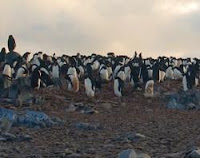 Last week the National Wildlife Federation issued a detailed report on the potential effects of sea level rise in the Chesapeake Bay. The report assumes a mean sea level rise of 11 inches by 2050 and 27.2 inches by 2100. This represents the high end of the IPCC's most recent climate forecast. Some climatologists, such as James Hansen, predict that the sea level will rise much faster – up to 5 meters by 2100. The Delmarva Peninsula is particularly vulnerable to sea level changes because of its flatness and long coastline. Around the Chesapeake, sea level rise is exacerbated by land subsidence since so much water is diverted for agriculture.
Last week the National Wildlife Federation issued a detailed report on the potential effects of sea level rise in the Chesapeake Bay. The report assumes a mean sea level rise of 11 inches by 2050 and 27.2 inches by 2100. This represents the high end of the IPCC's most recent climate forecast. Some climatologists, such as James Hansen, predict that the sea level will rise much faster – up to 5 meters by 2100. The Delmarva Peninsula is particularly vulnerable to sea level changes because of its flatness and long coastline. Around the Chesapeake, sea level rise is exacerbated by land subsidence since so much water is diverted for agriculture.
With a 27.2-inch sea level rise, the Chesapeake Region would lose many of its characteristic habitats. Tidal marshes on the whole would decline by 36% – with many freshwater marshes turning into saltmarsh. Tidal swamps would decline by 57%. Over 167,000 acres of dry land would disappear. Ocean and estuarine beaches would each decline by more than half. In their place would be over 266,000 more acres of open water.
Within the Chesapeake Region, one of the most vulnerable places is the area around Blackwater National Wildlife Refuge. The peninsula surrounding Blackwater currently consists of a diverse mixture of freshwater marshes, swamps, coastal forest, and agricultural lands. By 2100, most of the freshwater marshes and swamps would disappear. They would be replaced mostly by saltmarsh and open water.
You can get some idea of how the Blackwater region would change by looking at the maps below. As you can see, most of the refuge – the area enclosed by the purple line – would be under water by 2100. Such a drastic change in habitats would force the waterfowl that currently winter around the refuge to look elsewhere. Where they would go remains to be seen.
All maps were produced by the National Wildlife Federation for the report. (Click to enlarge)
(crossposted)





























